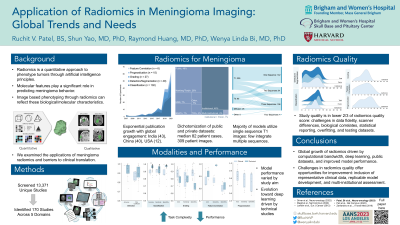Application of Radiomics in Meningioma Imaging: Global Trends and Needs
Friday, April 21, 2023


Ruchit V. Patel, BS
Medical Student
Brigham and Women's Hospital/Harvard Medical School
Brookline, Massachusetts, United States
ePoster Presenter(s)
Introduction: Quantitative analyses of imaging through radiomics is a powerful technology to non-invasively assess molecular correlates, provide prognostic information, and guide clinical decision-making. There has been growing interest in applying image-based phenotyping to meningiomas, a tumor with complexities in monitoring and management.
Methods: We systematically reviewed all meningioma radiomics analyses published in PubMed, Embase, and Web of Science until 12/20/2021. We compiled performance data and assessed publication quality using the Radiomics Quality Score (RQS).
Results: 170 eligible publications were grouped into five categories of radiomics applications to meningiomas: tumor detection and segmentation (21%), classification across neurological diseases (54%), grading (14%), feature correlation (3%), and prognostication (8%). A majority focused on technical model development (73%) versus clinical applications (27%), with increasing adoption of deep learning. Studies dichotomized between private institutional (50%) and public (49%) image datasets, but rarely used both (1%). For detection and segmentation of meningiomas, radiomic models had a mean accuracy of 93.1±8.1% and a dice coefficient of 88.8±7.9%. Classification of meningiomas had a mean accuracy of 95.2±4.0%. Grading of meningiomas had a mean AUC of 0.85±0.08. Correlation with tumor biological features had a mean AUC of 0.89±0.07. Prognostication of meningioma clinical course had a mean AUC of 0.83±0.08. Study quality was low overall, with a mean RQS of 6.7±5.9 (out of range -8 to 36). Clinical studies had a higher mean RQS (8.3±6.6) compared to technical studies (6.1±5.4). The greatest limitations in study quality spanned model development, prospective validation, and utility assessment.
Conclusion : Meningioma radiomics has observed exponential global growth, driven by data accessibility, novel computational methodology, and improving model performance. While tumor detection, segmentation, and classification have been broadly studied, translatability toward more complex tasks such as prognostication requires clinical studies that improve quality, develop comprehensive patient datasets, and engage in prospective multi-institutional trials.
Methods: We systematically reviewed all meningioma radiomics analyses published in PubMed, Embase, and Web of Science until 12/20/2021. We compiled performance data and assessed publication quality using the Radiomics Quality Score (RQS).
Results: 170 eligible publications were grouped into five categories of radiomics applications to meningiomas: tumor detection and segmentation (21%), classification across neurological diseases (54%), grading (14%), feature correlation (3%), and prognostication (8%). A majority focused on technical model development (73%) versus clinical applications (27%), with increasing adoption of deep learning. Studies dichotomized between private institutional (50%) and public (49%) image datasets, but rarely used both (1%). For detection and segmentation of meningiomas, radiomic models had a mean accuracy of 93.1±8.1% and a dice coefficient of 88.8±7.9%. Classification of meningiomas had a mean accuracy of 95.2±4.0%. Grading of meningiomas had a mean AUC of 0.85±0.08. Correlation with tumor biological features had a mean AUC of 0.89±0.07. Prognostication of meningioma clinical course had a mean AUC of 0.83±0.08. Study quality was low overall, with a mean RQS of 6.7±5.9 (out of range -8 to 36). Clinical studies had a higher mean RQS (8.3±6.6) compared to technical studies (6.1±5.4). The greatest limitations in study quality spanned model development, prospective validation, and utility assessment.
Conclusion : Meningioma radiomics has observed exponential global growth, driven by data accessibility, novel computational methodology, and improving model performance. While tumor detection, segmentation, and classification have been broadly studied, translatability toward more complex tasks such as prognostication requires clinical studies that improve quality, develop comprehensive patient datasets, and engage in prospective multi-institutional trials.
